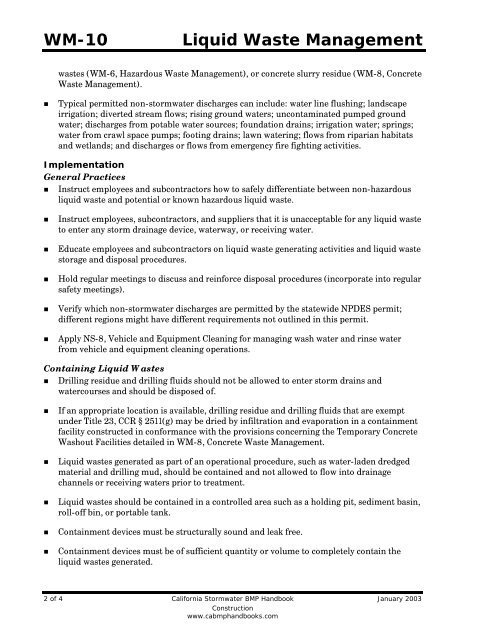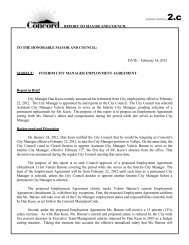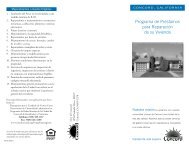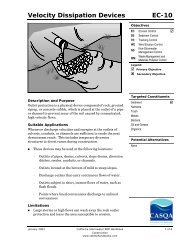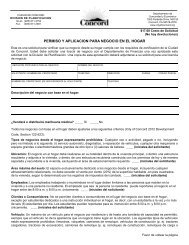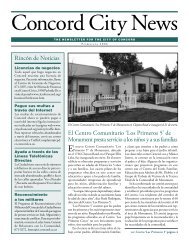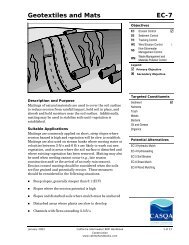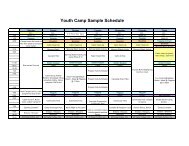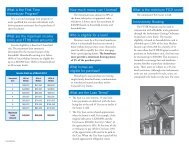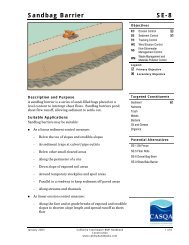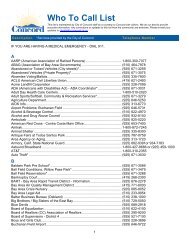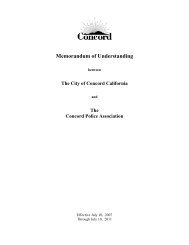Liquid Waste Management WM-10 - (BMP) Handbooks
Liquid Waste Management WM-10 - (BMP) Handbooks
Liquid Waste Management WM-10 - (BMP) Handbooks
You also want an ePaper? Increase the reach of your titles
YUMPU automatically turns print PDFs into web optimized ePapers that Google loves.
<strong>WM</strong>-<strong>10</strong><strong>Liquid</strong> <strong>Waste</strong> <strong>Management</strong>wastes (<strong>WM</strong>-6, Hazardous <strong>Waste</strong> <strong>Management</strong>), or concrete slurry residue (<strong>WM</strong>-8, Concrete<strong>Waste</strong> <strong>Management</strong>).• Typical permitted non-stormwater discharges can include: water line flushing; landscapeirrigation; diverted stream flows; rising ground waters; uncontaminated pumped groundwater; discharges from potable water sources; foundation drains; irrigation water; springs;water from crawl space pumps; footing drains; lawn watering; flows from riparian habitatsand wetlands; and discharges or flows from emergency fire fighting activities.ImplementationGeneral Practices• Instruct employees and subcontractors how to safely differentiate between non-hazardousliquid waste and potential or known hazardous liquid waste.• Instruct employees, subcontractors, and suppliers that it is unacceptable for any liquid wasteto enter any storm drainage device, waterway, or receiving water.• Educate employees and subcontractors on liquid waste generating activities and liquid wastestorage and disposal procedures.• Hold regular meetings to discuss and reinforce disposal procedures (incorporate into regularsafety meetings).• Verify which non-stormwater discharges are permitted by the statewide NPDES permit;different regions might have different requirements not outlined in this permit.• Apply NS-8, Vehicle and Equipment Cleaning for managing wash water and rinse waterfrom vehicle and equipment cleaning operations.Containing <strong>Liquid</strong> <strong>Waste</strong>s• Drilling residue and drilling fluids should not be allowed to enter storm drains andwatercourses and should be disposed of.• If an appropriate location is available, drilling residue and drilling fluids that are exemptunder Title 23, CCR § 2511(g) may be dried by infiltration and evaporation in a containmentfacility constructed in conformance with the provisions concerning the Temporary ConcreteWashout Facilities detailed in <strong>WM</strong>-8, Concrete <strong>Waste</strong> <strong>Management</strong>.• <strong>Liquid</strong> wastes generated as part of an operational procedure, such as water-laden dredgedmaterial and drilling mud, should be contained and not allowed to flow into drainagechannels or receiving waters prior to treatment.• <strong>Liquid</strong> wastes should be contained in a controlled area such as a holding pit, sediment basin,roll-off bin, or portable tank.• Containment devices must be structurally sound and leak free.• Containment devices must be of sufficient quantity or volume to completely contain theliquid wastes generated.2 of 4 California Stormwater <strong>BMP</strong> Handbook January 2003Constructionwww.cabmphandbooks.com


